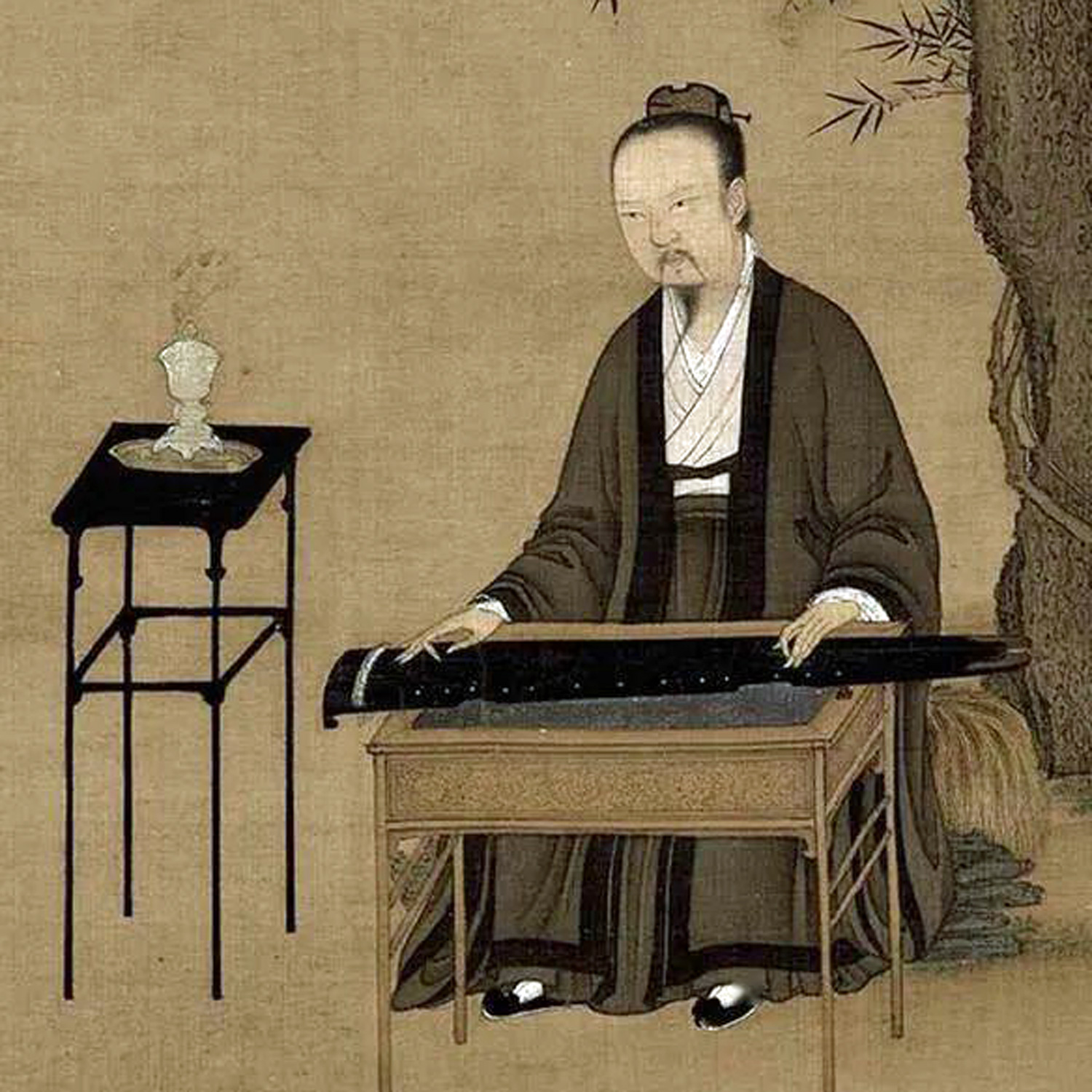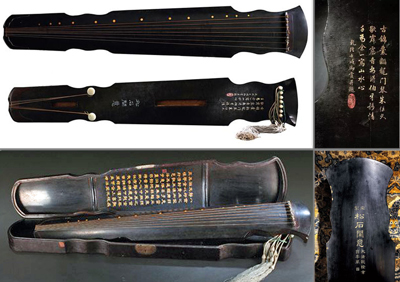|
T of C
Home |
My Work |
Hand- books |
Qin as Object |
Qin in Art |
Poetry / Song |
Hear, Watch |
Play Qin |
Analysis | History |
Ideo- logy |
Miscel- lanea |
More Info |
Personal | email me search me |
| Qin Shi Xu | 首頁 |
|
Song Huizong
Penultimate emperor of the Northern Song dynasty |
宋徽宗 1
琴史續 #1 2 |
| Huizong plays qin (expand)3 |
 Song emperor Huizong, original name Zhao Ji (1082 - 1135) reigned as emperor 1101-1126. His connection to the qin is emphasized by the famous painting at right, now in the Palace Museum Beijing. He is variously said to have painted it, and to be the person in the center playing the qin at a table in a garden. This is also perhaps the earliest known depiction of the qin being played at a table. There have also been other paintings that associate Huizong with the qin.4
Song emperor Huizong, original name Zhao Ji (1082 - 1135) reigned as emperor 1101-1126. His connection to the qin is emphasized by the famous painting at right, now in the Palace Museum Beijing. He is variously said to have painted it, and to be the person in the center playing the qin at a table in a garden. This is also perhaps the earliest known depiction of the qin being played at a table. There have also been other paintings that associate Huizong with the qin.4
An artist himself, Huizong heavily patronized the arts and spent a lot supporting Daoism and Daoist hermits.5 He also engaged in many musical activities other than those involving the qin. For example, in 1103 he established an imperial music bureau called the Bureau of Great Brilliance (Dasheng Fu).6 He also sent people around the country to collect a variety of music instruments.7 His passion for the arts is perhaps a significant reason for his being unable to keep the Jin from conquering northern China.8 In 1126 he abdicated in favor of his eldest son, but the following year the Jin captured them both, ending the Northern Song period.
Song Huizong's qin-related activities, in particular his interest in collecting qins, are discussed in Qinshi Chubian, Chapter 6a5. Clearly he was especially fond of the qin. In addition to playing, he had research on the various types of qin carried out by a music master, Liu Bing.9 His biography mentions only one specific qin by name, Spring Thunder, but he certainly had other well-known qins, whether or not they actually number the 10,000 claimed for his Pavilion of 10,000 Qins.11 The story relayed suggests that the Jin emperor, who presumably acquired this qin after the Jin overthrew the Song rulers, tried to have it buried with him. It is not clear whether this actually happened then but was subsequently unearthed by Qiao Da,12 and it is also not clear what happened to it after Qiao Da. However, another qin said to have been in Huizong's collection became famous in 2010 for the high price it seems to have commanded at an auction.13
The original essay in Qin Shi Xu is as follows:14
More to be added.15
Footnotes (Shorthand references are explained on a
separate page)
1.
宋徽宗 Song Huizong (r. 1101-1126)
(Wikipedia)
Main reference: Patricia Buckley Ebrey, Emperor Huizong; Harvard U Press, 2014.)
Born 趙佶 Zhao Ji (1082 - 1135), he was the 11th son of 神宗 Shenzong (r. 1068 - 1086). Shenzong was succeeded by his sixth son 趙煦 Zhao Xu (1076 - 1101), who reigned as 哲宗 (1086-1101). When Zhao Xu died without heirs, Zhao Ji became emperor. Huizong was succeeded by his eldest son, who reigned for only one year as Emperor Qinzong before the Jurchens conquered Kaifeng and established the Jin dynasty. Meanwhile another son of Huizong escaped to the south and established the Southern Song dynasty based in Hanghzhou, reigning from there as Song Gaozong.
More under Xu Jian, p.93; also see
Rao Zongyi.
(Return)
2. Six lines; sources given in Qin Shi Xu are:
- 宋史 Song Shi (its Music Annals [樂志 Yue Zhi; ctext]?)
- 雲煙過眼錄 Yunyan Guoyan Lu (43170.263 [Song;
ctext)
(Return)
| 3. 聽琴圖 Illustration of listening to the qin (expand) | Closeup of Huizong playing (expand) |
 This painting, called Listening to the Qin (聽琴圖 Ting Qin Tu), can also be seen in various art books, for example, Three Thousand Years of Chinese Painting, p.122. Its commentary says that the two listeners are high officials, including the prime minister, 蔡京 Cai Jing (1046 - 1126), who wrote the poetic inscription at the top. The original text of the inscription is:
This painting, called Listening to the Qin (聽琴圖 Ting Qin Tu), can also be seen in various art books, for example, Three Thousand Years of Chinese Painting, p.122. Its commentary says that the two listeners are high officials, including the prime minister, 蔡京 Cai Jing (1046 - 1126), who wrote the poetic inscription at the top. The original text of the inscription is:
There is more mention of Huizong's painting, with examples, in his
Wikipedia entry.
(Return)
4. There are further examples of his painting linked from his Wikipedia entry. (Return)
5.
Huizong and Daoism
See Ebrey
(Return)
6.
Imperial Music Bureau (大晟府 Dasheng Fu)
5960.1128 大晟詞 Dasheng Ci (Great Splendor Lyrics) describes a Great Splendor Bureau (大晟府 Dasheng Fu) established during the Xining period (1068-78); it concerned court music (yayue), 選用詞人及音律家日製新曲 selecting and using poets and music specialists daily to create new melodies, called Great Splendor Lyrics. On the other hand, Hucker, #6016, says the Dasheng Fu was,
This sounds like what Ebrey refers to as the Bureau of the Music of Great Brilliance (大晟樂 Da Sheng Yue), discussed further under Liu Bing,
below. Hucker does not say what happened to this bureau after 1120. I am not sure of its relationship to the Dasheng Yuefu that QSCB says existed from 1002-06, and I also do not know whether any attempt was made at that time to recreate functions of the earlier Music Bureau (樂府 Yue Fu).
(Return)
7.
See for example the story of Liu Bing related below.
(Return)
8.
金代 Jin dynasty
Not being Han they are cast as intruders but their support for Chinese culture is well documented. For music see
Rao.
(Return)
9.
劉昺 Liu Bing
劉昺 Liu Bing (Bio/629) was a 大司樂 Music Master in the court of Huizong. He was appointed director of the
Imperial Music Bureau (大晟付 Dasheng Fu, literally Bureau of Great Brilliance but apparently also known as, or at least responsible for, 大晟樂 Da Sheng Yue Music of Great Brilliance) and as such compiled a Book of the Music of Great Brilliance
(大晟樂書 Dasheng Yueshu). During 1105-8 the Bureau introduced new court music (Ebrey, p.164). Liu was also involved in a project to collect "art objects and ancient vessels" (Ebrey, p.262-3). The Music Annals of the Song Dynastic History are reported to have said that, after Huizong
ordered Liu Bing to find out what different sorts of qins there were, he found five types:
one-string, three-string, five-string, seven-string and
nine-string. All were in the silk-string category.
(Return)
11.
10,000 Qin Pavilion (萬琴堂 Wan Qin Tang)
25455.xxx. Mentioned in the Bio but does not seem to be in its listed sources.
(Return)
12.
Qiao Da 喬達
Qiao Da (4114.67) was a member of the Hanlin Academy during the Yuan dynasty.
(Return)
| 13. Auctioned qin said to have belonged to Song Huizong (expand) | 松石間意 Songshi Jianyi and its box |
 A guqin named (The Idea of) Stones among the Pine Trees (松石間意 Songshi Jianyi), once in the collection of Song Huizong then later belonging to the Qing dynaty Qianlong emperor (1711-1799), who inscribed it and had a special case made to contain it, is said to be the most expensive acoustic instrument ever sold: in December 2010 at a Poly International Auction in Beijing for over US$20,000,000. The provenance is interesting and apparently accepted, but some have questioned whether this was really the actual sale price.
A guqin named (The Idea of) Stones among the Pine Trees (松石間意 Songshi Jianyi), once in the collection of Song Huizong then later belonging to the Qing dynaty Qianlong emperor (1711-1799), who inscribed it and had a special case made to contain it, is said to be the most expensive acoustic instrument ever sold: in December 2010 at a Poly International Auction in Beijing for over US$20,000,000. The provenance is interesting and apparently accepted, but some have questioned whether this was really the actual sale price.
If such antiques are to go into private collections Chinese law apparently requires them to be put on public display for five years after sale, but as of 2018 this guqin was aooarenntly still on exhibit at the Poly Art Museum in their office complex in Beijing. When I saw it there in 2015 I was underwhelmed: except for the inscriptions its appearance did not seem exceptional, particularly the lacquer on the qin top; perhaps this was due to the light in the museum and the fact that the instrument was behind glass. (Images are copied from various internet websites that don't give their sources.)
(Return)
14.
Original preface
The original preface begins,
徽宗諱佶。神宗第十一子。初瘋端王。哲宗崩,無子嗣。。。。
(Return)
15.
Further
For another painting attributed to Huizong see
Dao Yi Qu.
(Return)
Return to QSCB, or to the Guqin ToC.